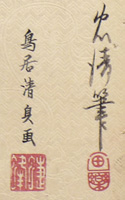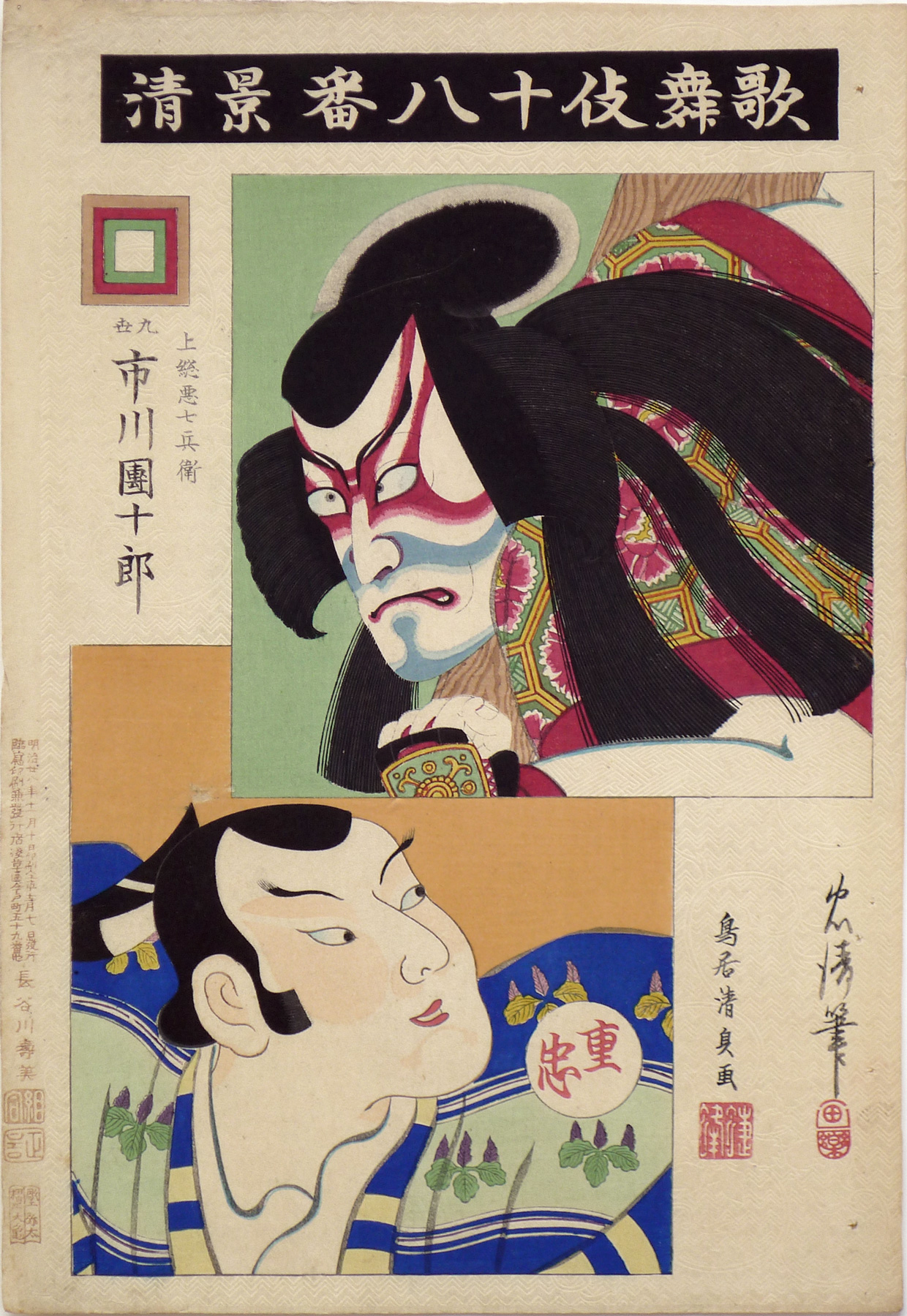About This Print
Ichikawa Danjūrō IX, in the upper right panel, playing the role of Kazusa Akushichibei 上総悪七兵衛 in the kabuki play Kagekiyo 景清. He wears "the exaggerated kumadori [stage makeup associated with the aragotostyle], bushy hair and gold brocade of the 'loyal warrior'..."1 Below Danjūrō is an unidentified actor playing the role of Shigetada 重忠. The Ichikawa family crest (mon) of nested squares is shown to the left of Danjūrō, beneath which appears 九世市川団十郎 (9th Generation, Ichikawa Danjūrō) and the character played 上総悪七兵衛 (Kazusa Akushichibei).The Play Kagekiyo
Source: Naritaya website http://www.naritaya.jp/english/compendium/dictionary_04.html"The role of the famous Heike warrior Akushichibyoe Kagekiyo is a signature one for the Ichikawa family, and the play is part of the Kabuki Eighteen. The role was first played by Danjuro IV, whose thin frame and long face made him unsuitable for the pure Ichikawa aragoto roles. Instead he developed his art in other directions, playing the logical and loyal heroes known as jitsugotoshi, as well as villain (katakiyaku) roles. He enjoyed huge success with the part of Kagekiyo. The part adds a new psychological dimension to aragoto, in that Kagekiyo is imprisoned by his enemies, and endures a tearful reunion with his wife and children before smashing his way out of the prison in which he is being held. The make-up he developed for the role used black lines, suggesting his evil nature. Later generations of Danjuro continued to play the role, and it had a special significance for Danjuro VII, who acted it to celebrate his return to Edo after seven yearsí banishment. Perhaps we can sense a hint of pride in the way he used Kagekiyo's escape from prison to mirror his own banishment and return."
The Kabuki Eighteen
Source: Kabuki Encyclopedia, An English-Language Adaption of Kabuki Jiten, Samuel L. Leiter, Greenwood Press, 1979, p. 152."The Kabuki Eighteen," a collection of plays established by Ichikawa Danjūrō VII, stresses the special aragoto acting art of the Danjūrō line. In the Meiji period other acting families began to gather their most successful plays into similar collections. See the Title Page from the series The Kabuki Eighteen (Kabuki Juhachiban) for a list of the plays.
1 The Kabuki Handbook, Aubrey S. & Giovanna M. Halford, Charles E. Tuttle Company, 12th printing 1981, p. 122.
Print Details
| IHL Catalog | #722 |
| Title or Description | Ichikawa Danjuro IX as Kazusa Akushichibei in the play Kagekiyo 九卋市川団十郎 上総悪七兵衛 景清 |
| Series | The Kabuki Eighteen (Kabuki Jūhachiban) 歌舞伎十八番 |
| Artist | Torii Kiyosada (1844-1901) and Torii Kiyotada VII (1875-1941) |
| Signature |  left-most signature: 鳥居清貞画 Torii Kiyosada ga followed by Chōhō seal |
| Seal | Tadakiyo seal right - Kiyosada seal left |
| Publication Date | December 7, 1895 (Meiji 28) 明治廿八年十二月七日 |
| Publisher | 長谷川寿美 Hasegawa Sumi [Marks: seal 25-406 長谷川寿美; publisher ref. 102] The two square seals, at the bottom of the detail of the publishing information, shown left, are associated with a number of publishers during the 1890s, including the publishers Hasegawa Sumi 長谷川寿美 and Komori Sōjirō 小森宗次郎. They often appear near the publisher's name. Taken together, the seals read Kumiai seigen 組合正言. Kumiai can be translated as "guild" and seigen can be translated as "censor" (using the Chinese meaning for the word.) So, we may have some type of publisher's guild approval or censor seal. click on the image to enlarge |
| Engraver |  |
| Printer | 摺工大亀 Surikō Ōkame (left part of cartouche shown above) |
| Impression | excellent - extensive embossing |
| Colors | excellent |
| Condition | good - not backed; soiling throughout; binding holes right margin |
| Genre | ukiyo-e; yakusha-e |
| Miscellaneous | The two square seals, shown left, are associated with a number of publishers during the 1890s, including the publishers Hasegawa Sumi 長谷川寿美 and Komori Sōjirō 小森宗次郎. They often appear near the publisher's name. Taken together, the seals read Kumiai seigen 組合正言. Kumiai can be translated as "guild" and seigen can be translated as "censor" (using the Chinese meaning for the word.) So, we may have some type of publisher's guild approval or censor seal. |
| Format | vertical oban |
| H x W Paper | 14 1/2 x 10 in. (36.8 x 25.4 cm) |
| Literature | |
| Collections This Print | Museum of Fine Arts, Boston RES.53.14; Tokyo Metropolitan Library 5721-C008-15; Tsubouchi Memorial Theatre Museum of Waseda University 201-0137 and 201-0158 and 201-0177; Jordan Schnitzer Museum of Art, University of Oregon MWJ51:T98 |
4/11/2020


